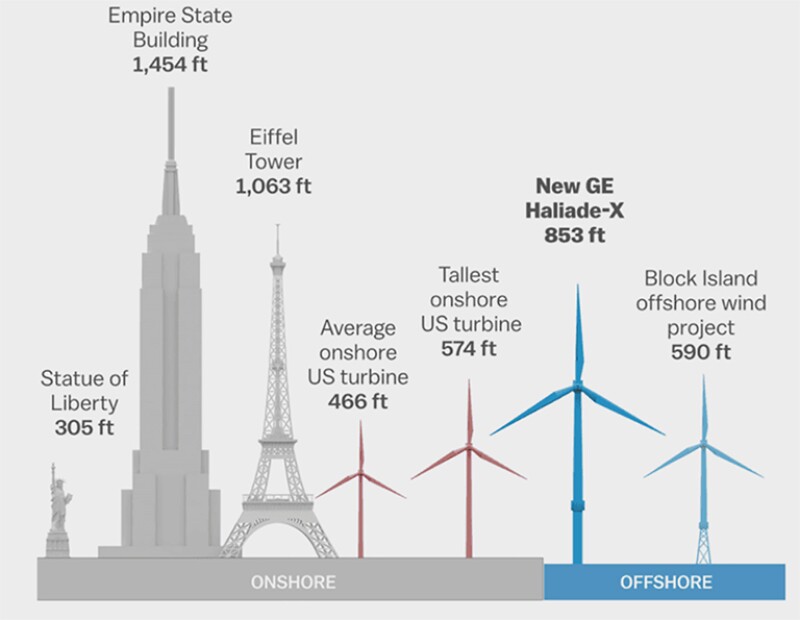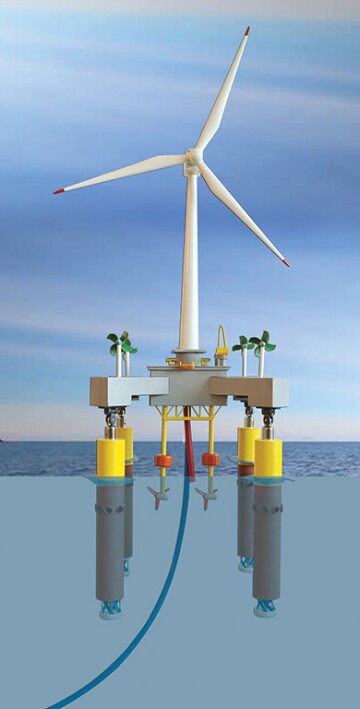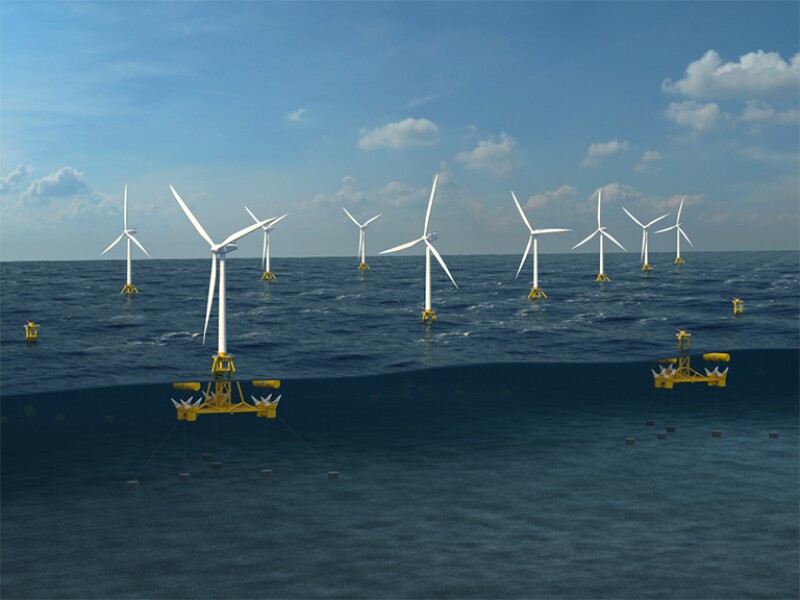A Shell engineer used the word “boom” in the present tense during a panel discussion at the Offshore Technology Conference (OTC).
“To me it feels like a boom time right now. It is amazing,” said Pierre Liagre, a senior civil and marine engineer for Shell.
No, he was not referring to oil and gas. The topic for that midday session was offshore wind technology challenges.
Liagre was one of the engineers on OTC panels who had made the change, along with Nastassja Hagan, vice president supply Low Carbon Energy, Finance for BP. They both said wind will provide opportunities for innovative engineers with an appetite for change.
“There is a lot of immaturity in the renewable sector and a lot of opportunities,” Hagen said. The word immature was used more than once that day, as was de-risking, to describe some big, interesting problems ahead for wind engineers.
The technological challenges and risks come in many forms. There are heavy lifts in high seas, turbines to maintain in towers nearly as tall as the Eiffel Tower—1,063 ft high, and megaprojects to manage and design turbines to survive hurricanes. Above all, engineers need to figure out how to do it cheaper and faster.

Offshore wind offers obvious opportunities for those who design, build, and manage offshore facilities. The first generation of offshore wind turbines were built to stand on the shelf in water up to about 200 ft, like shallow-water oil platforms. In deeper waters, the economics favors floating structures.
The first generation of offshore structures were based on oil-industry models. A slide from the US National Renewable Energy Laboratory (NREL) described the results as “successful, but bulky and expensive.”
That tart bottom line is a reminder that while oil-industry knowledge and experience is valuable, it must be adapted for wind projects.
“It is different, but similar,” said Nick Prokopuk, offshore wind business developer for TotalEnergies.
There are skills that are transferable from offshore oil to wind such as designing and building jackets and substations for offshore platforms or lifting and handling large objects safely.
Among the many problems facing the young US offshore business, safety loomed large in Prokopuk’s mind. Based on the early work in the US, the total recordable incident rate is “not sustainable and not acceptable.”
Petroleum engineering is not an obviously transferable skill for offshore wind. There is no wind in the subsurface. But Hagen said higher math and modeling skills are needed to analyze wind resource data or complicated financial performance analysis.
A key for anyone making this change is a willingness to adapt. “You have to have an appetite for learning; you want to learn all the time,” Hagen said.
Rules To Break
Offshore wind sometimes requires doing something that engineers in the oil business would advise against trying.
Ideally, wind platforms work reliably for a long time using a mix of automation and remote monitoring and control. There is no one on board to maintain it and the equipment is hard to reach. “Mobilizing an offshore construction vessel to replace the blade or gearbox could turn out to be extremely expensive,” Liagre said.
While he speculated about the possibility of engaging a climbing crane to lift heavy objects up more than 300 ft, he said minimizing repairs is the best option.
In the oil business, offshore wind installations would be described as a normally unattended facility (NUF). Oil companies are looking for ways to build larger, more complex, unstaffed offshore facilities to save money and reduce offshore safety risks.
During an OTC panel about the future of NUFs, Patrick Moore, instrument and controls advisor for ExxonMobil, offered a quick summary of what it takes to build a successful NUF for oil and gas operations.
Electric power is critical to power and control equipment and eventually, robots, on those installations. But he strongly advised against putting the primary power source on board. “Power generation equipment is one of those things that requires a high level of maintenance,” Moore said.
He offered a detailed description of what it would take to supply power from shore. The costs rises with distance, ultimately reaching the point where the expense is so high an NUF is not a practical alternative.
Meanwhile, it is the job of an offshore wind engineer to build large numbers of what amount to NUFs where high-performance rotating machinery is at the heart of a large structure where breakdowns are likely to be costly.
Minimizing those issues will create opportunities for experts in digital monitoring and predictive maintenance, as well as those with expertise in simplifying mechanical designs and sensor and corrosion management.
And the oil industry, including companies such as ExxonMobil that are not directly involved in wind, may benefit from work in offshore wind where the problem must be solved.
“There is a huge opportunity in low-maintenance, high-reliability power generation solutions. We know what we need, we just do not have a solution yet,” Moore said.
Getting Paid
In the 5 years since Roy Robinson jumped from offshore oil to renewables, the marine engineer has enjoyed being in a spot where innovation is required. He recommends it for those with an innovative streak.
“They can go back to why they became an engineer and let their brain wander and think, what if?” said Robinson who maximized his opportunity for independent thinking by becoming an entrepreneur. His business plan could be loosely described as finding a practical application to a childhood fantasy of building places to live and work on the ocean.
When he talks to investors as CEO of Excipio Energy, the plan is to build a floating platform designed to accommodate multiple sources of wind- and water-powered energy, as well as any other paying tenants with compatible operations, such as aquaculture.
It is a long-term project. To pay the bills he does offshore consulting. He currently is working on a study for the US Department of Energy (DOE) considering possible applications for idle offshore oil and gas platforms.
For those in oil looking for a job with a steady paycheck in another business, there are opportunities in renewables. The work can be interesting, but Robinson warns the pay is likely to be significantly lower.
Rodolfo Sancio, a senior principal and geotechnical group manager for Geosyntec Consultants, also sees a differential when it comes to paying for consulting work.
Geosyntec’s list of offshore clients is still focused on oil and gas, but the geotechnical and environmental consulting firm is working to take advantage of the rapid growth ahead in offshore wind.
The problems posed by those clients are familiar. Sancio said its projects have included analyzing whether screw piles could be used in a foundation for a North Sea wind structure and evaluating sites to identify potential hazards for wind turbines.
Newcomers in this business face stiff competition from European firms. “Europeans are ahead of us by two decades. Catching up is difficult. The US is relying on labor and know-how from Europe,” said Sancio.
Looking ahead, he sees the supply-demand relationship becoming more favorable as offshore wind goes global. That optimism is supported by the annual NREL Offshore Wind Market Report showing potential work to come along the US east coast, and some off the west coast.
It predicts US offshore wind production to grow from just above zero—about 30 MW—in 2020 to from 19 to 25 GW by 2030. US President Joe Biden has announced a 30-GW goal.
To put it in perspective, Sancio pointed out that to date there are six offshore turbines installed off the US with a total capacity of 30 MW. To reach the president’s goal, more than 2,900 additional 10-MW towers would be needed, though the actual number is likely to be closer to 2,000 because 15-MW towers are becoming common.
“How can I ignore that, if I have some skills and can get into that market?” said Sancio, who expects that increased demand for a limited supply of offshore engineering talent should increase rates.
Not Hiring Yet
So far, the number of workers added by US wind players has been limited. That may change soon with development expected to accelerate between 2023 and 2025, according to the NREL.
Years of detailed engineering work will be needed to manage the design and construction of TotalEnergies’ wind program, which Prokopuk estimated could keep 150 persons busy.
The job outlook from the American Clean Power Association, which put on the panel at OTC, said renewable jobs will be concentrated in manufacturing, construction, project development, and operations, according to its job report.
Based on that report, which draws on data from the US Bureau of Labor Statistics (BLS), engineers do earn less in wind than oil, though averages for highly skilled technical people can cover a wide range of salaries.
Demand for electronic and electrical engineers will rise the most among engineers. Their average pay was estimated to range from $105,000 to $112,000, based on data from the BLS from May 2020.
There will also be rising demand for mechanical and civil engineers, both of which are estimated to earn just less than $100,000 a year. At the top of the pay categories are architectural and engineering managers, earning more than $150,000.
The 2020 SPE Salary Survey showed the average petroleum engineer earned nearly $165,000, which is higher than the engineering averages in clean energy. But that was down from $197,000 from the year before so the trend needs to be considered in pay comparisons.
Word Association? Boom
Oil-industry veterans asked for a word associated with “boom” would likely answer “bust.”
Robinson knows that from personal experience. He decided to do something completely different after Repsol shut down the unit where he worked. He sees good things ahead for wind.
“It is a boom. It may be a very long-lasting boom,” he said, adding, “It is now a boom for everything. Eventually it will be a boom for those that are more efficient.”
His business model assumes that the profit margins in wind are not enough to support the oil-industry standard of one energy source per platform.
“Oil and gas is used to drilling holes in ground and money comes out,” Robinson said.
The long-term production from a big deepwater field can make a billion-dollar platform seem like a modest upfront investment on a long-lived stream of oil and gas income, which can be extended by tying back smaller finds nearby.
A better comparison for the wind business now might be the shale oil business a decade ago when oil was selling for $100/bbl and the potential of those massive plays looked endless.
Shale was the transitional play for a shrinking US onshore oil production. There was risk there—the upfront cost of fracturing these wells was high and the period of peak production short. But it was assumed that this immature technology could be improved to make it profitable. Investment money poured in based on the belief that those advances plus efficient factory-style development would make this a huge winner.
That glow started to dim 7 years ago when oil and gas prices crashed, in large part due to the flood of shale oil and gas. That lead to cost cutting, job cutting, and consolidation which finally has allowed shale operators to generate the profits and dividends long promised to investors.
The cash flow for electric generators looks stable in comparison. While the upfront investment in wind is large, ever larger turbines are more efficient, advances are expected in the immature technology, and electric contracts offer a long-term source of income.
But that could change. Plans for explosive growth in wind, solar, and battery storage capacity assume it will replace a significant percentage of the coal- and gas-fired generators which now provide the vast majority of the electric power. In Europe, a rising tax on carbon emissions will push owners of fossil fuel plants to shut them down. The US has no such mechanism, and there is stiff opposition to putting a price on carbon.
Electric power developers are anticipating less-favorable market conditions as more wind and solar capacity expands. At its recent investor day, Equinor said that as more developers push into renewable electric development, buyers in increasingly volatile power markets will have the leverage to negotiate less-favorable price formulas, which expose the seller to the pain if market prices drop.
Engineers planning wind projects, or considering their career options, need to consider the subtleties of power pricing when evaluating rosy predictions about the future of renewable energy.
For Robinson, the smart move is to assume that the offshore energy business a decade from now will be significantly different from what is expected.
Excipio’s plan would put it in the floating industrial real estate business. Robinson’s large platform is designed to accommodate wind, solar, and emerging technologies such as electric power from waves, tides, geothermal, and a technology that uses small differences in the water temperature, known as ocean thermal energy conversion (OTEC).

This diverse combination of technologies “is one way of de-risking the economics,” Rogers said, adding the caveat, “if the systems added are proven themselves.”
While the platform costs more, the overhead is distributed among multiple users who share a long list of common costs. Adding sources of energy that can generate power when the wind and sun are not reliable can create a steadier power supply, which is likely to be valuable as fossil fuel plants that can operate round the clock are phased out.
There are others around the world working on platforms with multiple energy sources. “When I started there were no floating wind concepts, now there are seven. And no proven hybrids, and now there are 12 designed for wind and something else,” he said.
Speakers representing the majors that day said they are thinking about hybrids, such as using offshore wind power during periods when electric demand and prices are low, to create storable forms of energy such as hydrogen from seawater
Robinson wants to maximize energy production by mixing multiple forms of generation on a single platform or group of platforms. Skeptics say that would be complex. Robinson counters that complexity is something the oil business lives with already.
Bringing together multiple forms of renewable energy also presents a cultural challenge.
Those in the oil business who complain about other disciplines working in silos will be able to continue to do so if they jump to renewables.
Robinson said at energy conferences “wind guys do not talk to the wave guys, wave guys don’t talk to the tidal guys, and no one talks to the OTEC guys because they [think they] are ‘crazy’.”
For engineers looking for oil options in wind, he advised broadening their research by thinking about opportunities in offshore energy.


